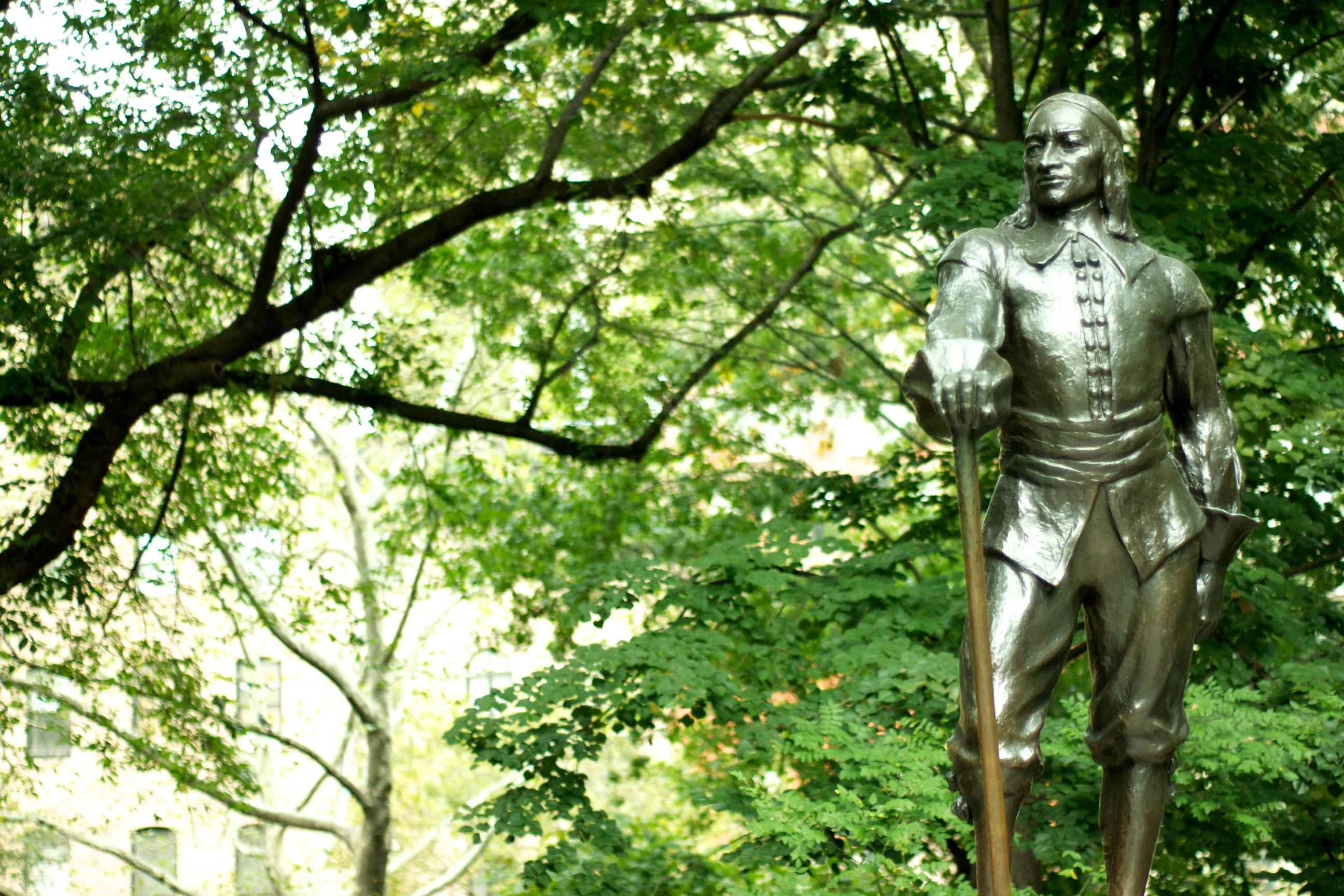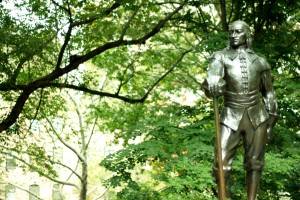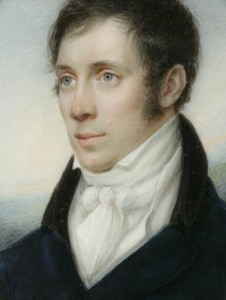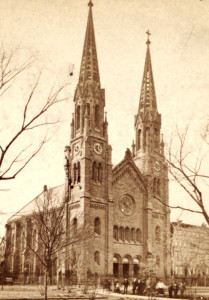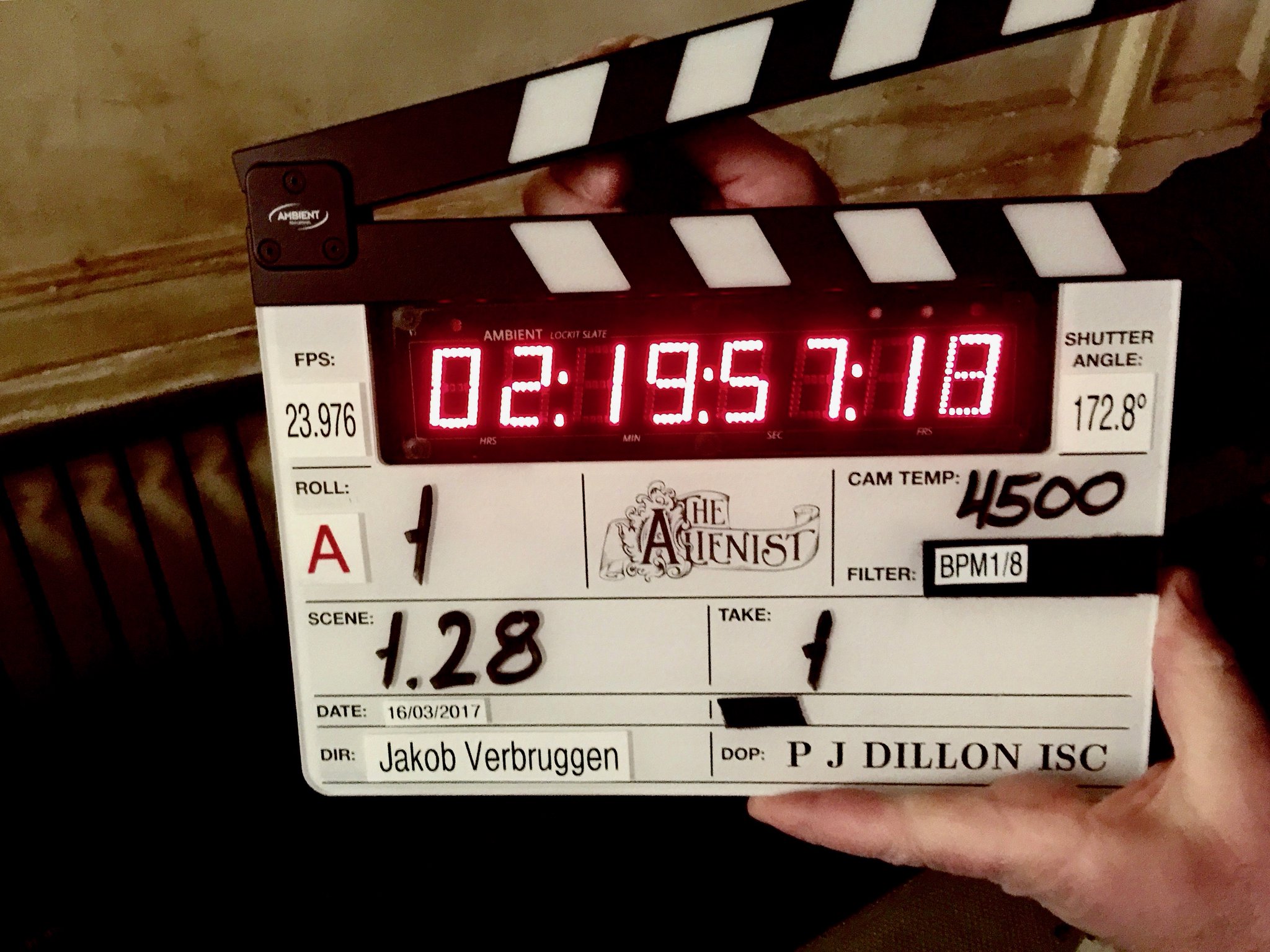It seemed appropriate to begin our travels into the past with the location that inspired the name of the website, so over the next few posts I’ve decided to address a question I’ve been frequently asked in the past: “Did Dr. Kreizler really live at 283 East 17th Street?” On the surface, this is an easy one to answer: “No, Dr. Kreizler is a fictional character so he did not really live anywhere.” But fact can often be more interesting than fiction, and this certainly proved to be the case for this question when I delved a little deeper. Do you know, for instance, who the real notable residents of East 17th Street and the Stuyvesant Square district were throughout the 19th century? Do you know why Caleb Carr might have selected the location? Before we dive straight in to addressing some of these questions, today’s post will provide a brief outline of the historical context of the square, starting with the park as a gift from the Stuyvesant family before moving onto the development and demographic composition of the district in its earliest days.
A gift from the Stuyvesant family
The origin of the Stuyvesant Square district traces back to the square’s namesake, Peter Stuyvesant, the famed mid-17th century Governor of New Amsterdam (New York) who purchased the land that Stuyvesant Square now occupies from the Dutch West India Company in 1651. The Governor’s land purchase was expansive and encompassed Bouwerij 1 (“Bouwerij” being the 17th century Dutch term for “farm”) which was usually reserved for each succeeding Director General, the pastureland north of Bouwerij 1, and part of Bouwerij 2. In later years, he went on to purchase the remainder of Bouwerij 2 and part of Bouwerij 3.
Stuyvesant’s property passed to his descendants following his death and in the mid-18th century his great-grandson, Petrus Stuyvesant, inherited most of the land encompassing the Stuyvesant Bouwerij. In 1787, Petrus extended, widened, and named “Stuyvesant Street,” the road that divided Bouwerij 1 and 2, and chose to live north of Stuyvesant Street in “Petersfield,” a farm located in the vicinity of the present 16th Street near Stuyvesant Square that had an uninterrupted view of the East River. Upon Petrus’s death in 1805, his two sons and daughters inherited the various farms that encompassed the original land of Governor Stuyvesant, with the Bowery farm located south of Stuyvesant Street inherited by his son Nicholas William, the “Leanderts” farm inherited by his daughters, and the Petersfield farm inherited by his son Peter Gerard Stuyvesant.
Second in wealth only to John Jacob Astor in the early 19th century, Peter Gerard and his wife Helen Rutherford agreed to sell a small plot of Petersfield to the City of New York for a token amount in 1836 under the dual conditions that the land be used as a public park with landscaping similar to Washington Square and that the city pay for the park to be enclosed by a fence similar to the one enclosing Union Square. This gift followed an earlier deed to the City in 1828 of land comprising the eastern sections of 10th Street through to 22nd Street. Although the philanthropic gift of parkland ensured that the district would always have a green oasis for public use, it also ensured that the pragmatic Peter Gerard’s remaining property that surrounded the park would retain its value as the city’s urban sprawl began its northward migration due to the 1815 extension of Second Avenue (the street that bisects the park) and Third Avenue north to 28th and 29th Streets.
Although the district became increasingly populated by the late 1840s and was beginning to lose its rural character, it was not until 1847 following years of litigation that the city finally honored its agreement with the Stuyvesant family and constructed the $20,000 handsome cast-iron Federal-style fence that still surrounds the park today. After the completion of landscaping in the years that followed, including the construction of its two large fountains, the park was formally opened to the public in 1850, and joined Washington Square, Gramercy Park, and St. John’s Square as an attractive district intended to be occupied by fashionable residents of the city. To ensure that the location maintained a genteel residential character, deed restrictions were put in place during the 1840s which forbade any “brewery, distillery, slaughter house, blacksmith shop, forge, furnace, soap, candle, starch, varnish, vitriol, glue, ink or turpentine factory, factory for canning, dressing or preparing shins, hides or leather or any cow or livery stable or cattle yard or any other dangerous, noxious or offensive establishment” from opening in the district.
The district attracts its first residents and religious institutions in the 1840s
Considered far uptown in the mid-19th century and largely undeveloped, the first families to move into the district tended to be those of merchants who viewed their lot leases from Peter Gerard Stuyvesant as an investment. One notable early merchant was William E. Dodge, member of a prominent New York firm, Phelps, Dodge, & Company, that dealt in copper and other metals, who leased several lots on 17th and 18th Streets from Peter Gerard in 1836 on the condition that houses would be constructed on each lot within a set number of years. The first houses built on the lots he leased that still stand today are a pair of three-story late Greek Revival houses at Nos. 214 and 216 East 18th Street which were constructed between 1842 and 1843. These residences are the oldest still standing in the district.
Dodge lived at No. 216 East 18th Street until 1853 when he moved to Madison Avenue, having purchased large tracts of pine lands and made wise investments in railway stock that led to him becoming a prominent figure in commercial circles. His leasing of lots in the Stuyvesant Square district had not been the profitable venture anticipated, however, and in 1854 he sold No. 214 and transferred the land lease to fellow merchant Francis Babcock who had been living in the house since 1849. Although he did fulfill his lease obligations between 1849 and 1850 for one additional lot on East 18th Street (No. 212 adjoining Nos. 214 and 216), he did not develop the other lots on 17th and 18th Streets that he had leased.
In addition to his commercial enterprises, Dodge was a noted philanthropist in the later years, and was heavily involved in religious societies, an active abolitionist, an activist for Native American rights, President of the Temperance Society, a founding member of the YMCA, and was elected a Representative to the Thirty-Ninth Congress, serving on the Committee for Foreign Affairs. Given his prominence in New York society, a bronze memorial statue of him was commissioned by the New York City Chamber of Commerce and placed in Herald Square shortly after his death in 1883. The statue can now be found in Bryant Park.
In addition to family residences, a number of store-residences were also built in the district in the 1840s. Most of these dwellings were modest three-story buildings with a store front occupying the ground floor and living quarters located on the upper floors. The only store-residence from this period that still stands in the district today is No. 171 Third Avenue, and was originally built in Greek Revival style for merchant John Pickersgill who had a row of similar buildings constructed adjacent to No. 171 that have now been demolished.
At the same time that these unpretentious homes and store-residences were being constructed in the district, the first of the religious buildings that would come to define the character of the district in later years was built on Rutherford Place at 16th Street. Established in 1752, St. George’s Episcopal Church had originally been located on Beekman and Cliff Streets as a chapel of Trinity Church. In 1811, the chapel became incorporated as St. George’s Church and separated from Trinity. Over the following thirty years, the church congregation grew in size to such an extent that it became too large for the original chapel, and moving to a larger purpose-built structure was necessitated. After a period of controversy and litigation with Trinity Church over the sale of the old chapel and investment lands, construction of the new St. George’s Church began in 1846 on land donated by Peter Gerard Stuyvesant directly opposite the newly landscaped park.
Designed by Leopold Eidlitz and Otto Blesch in an early Romanesque Revival style that was influenced by the Romanesque architecture of Southern Germany and Bohemia that both Eidlitz and Blesch admired, the handsome brownstone structure was opened in 1848 and officially completed in 1856. From its earliest days, the structure was considered one of the finest examples of early Romanesque Revival architecture in New York. In 1853, Putnam’s Magazine described it as the “most chastely designed and most sincerely built church in New York City–we are not afraid to say in the United States,” and New York Illustrated labeled it as one of the “first rank” of religious institutions in the United States in 1869 despite damage sustained in a fire four years previously that eventually resulted in the church’s loss of its twin openwork masonry spires in 1889 due to weakening from the fire damage.
The success of St. George’s Church during the years following the move to the Stuyvesant Square district confirmed that the structure’s generous proportions were warranted. As a result of the impassioned preaching of its evangelical rector, Reverend Dr. Stephen Higginson Tyng, the church drew some of the largest congregation numbers of any religious institution in New York City during the 1840s and 50s. Although the church would go through a lull in later years, its numbers would again rise during the period in which the Alienist books were set due to the prominent financier, J. P. Morgan, recruiting a passionate reformer as rector, Reverend Dr. William S. Rainsford, who went on to become a personal friend of Theodore Roosevelt. Given these connections to two such prominent figures in the Alienist books as well as the brief mention the church received in The Alienist, we will be revisiting the role that St. George’s Church played in shaping the character of the district in the late 19th century in a later post of the blog series.
Not long after the construction of St. George’s began, the Ladies Mission Society also founded a mission at No. 337 East 17th Street, between First and Second Avenues, in 1848. The following year, the mission was renamed the Hedding Methodist Episcopal Church after a prominent Methodist bishop who was active at the time, Elijah Hedding. A few years after establishing the mission, a large Neoclassical church with stone front was constructed at the location and was eventually dedicated in 1854. Like the nearby St. George’s, the church was designed to accommodate a large congregation (1,500 persons) and went on to become a well-attended religious institution during the 19th century.
To be continued
Following the establishment of the first religious institutions at the location in the late 1840s as well as completion of the park, significant construction took place in the Stuyvesant Square district in the 1850s with a number of residences getting built on 15th, 16th, 17th, and 18th Streets in the early years of the decade. In Part Two of the blog series, we will continue to learn about the types of residents the district attracted over the decades leading up to the critical period for the Alienist books, as well as learning more about the other religious institutions that came to help shape the character of the district for the remainder of the 19th century.

